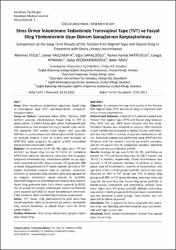Stres üriner inkontinans tedavisinde transvajinal tape (tvt) ve fasyal sling yöntemlerinin uzun dönem sonuçlarının karşılaştırılması

Göster/
Erişim
info:eu-repo/semantics/openAccessTarih
2014Yazar
Yücel, MehmetYalçınkaya, Soner
Saraçoğlu, Uğur
Hatipoğlu, Namık Kemal
Atakanlı, Cengiz
Dedekargınoğlu, Galip
Aras, Bekir
Üst veri
Tüm öğe kaydını gösterÖzet
Amaç: İdrar inontinans tedavisinde uygulanan fasyal sling ve transvaginal tape (TVT) operasyonlarının sonuçlarını karşılaştırmaktır. Gereç ve Yöntem: Çalışmaya Mayıs 2002- Temmuz 2008 tarihleri arasında inkontinansları fasyal sling ve TVT ile tedavi edilen 113 kadın hasta dahil edildi. Postoperatif ped kullanmama ve tam kuruluk hali başarı olarak kabul edildi. Ped sayısında %50 azalma kısmi başarı, ped sayısında %50’den az azalma başarısızlık olarak kabul edildi. İstatistik- sel analizde student t test ve ki-kare testi kullanıldı ve SPSS®18.0 paket programı ile yapıldı. p<0.05 istatistiksel olarak anlamlı olarak kabul edildi. Bulgular: Yaş ortalaması 52.94 (31-78), takip süresi TVT için 44.3±8.7 ay, fasyal sling için ise 74.7±12.4 idi. Hastaların %79.5’inde mikst tip inkontinans mevcuttu. Her iki grupta hastaların inkontinans tipi, inkontinans şiddeti ve yaş dağı- lımları benzerdi (p>0.05). Başarı oranları TVT grubunda %96 ve fasyal sling grubunda %77 olarak saptandı (p<0.001). TVT yapılan hastalarda kanama daha az saptandı, operasyon süresinin ve hastanede kalış süresinin daha kısa saptandı ve bu bulgular istatistiksel olarak anlamlı idi (p<0.05). Obstruktif bulgular ve postmiksiyonel rezidüel idrar oranları fasyal sling grubunda daha fazla olarak saptandı (p<0.05). Her iki grupta da mesane perforasyon oranlarına birbirine yakın saptandı (p>0.005) ve majör komplikasyon izlenmedi. Takip süresince hiçbir hastada teyp erozyonu saptanmadı. Sonuç: TVT, fasyal sling operasyonlarına göre daha kısa sürede yapılması, daha az kanamaya yol açması, hastanede kalış süresini kısaltması ve yüksek başarı oranı ile tercih sebebi olabilir. Objective: To compare the long term results of the Tension free Vaginal Tape (TVT) and fascial sling in treatment with stress urinary incontinence. Material and Methods: A total of 113 patients treated with Tension free vaginal tape (TVT) and fascial sling between May 2002 and July 2008 were included into the study. Complete dryness was accepted as success, 50% reduction in pad number was evaluated as partial success, and reduc- tion less than 50% in number of pad was evaluated as fail- ure. Statistical analysis was performed using SPSS®18.0 for Windows with the student t test for parametric variables, and the chi-square test for categorical variables. Statistical significance was considered at p<0.05. Results: Average of age was 52.94 (31-78), and follow-up periods for TVT and fascial sling were 44.3±8.7 months and 74.7±12.4 months, respectively. Mixed incontinence was present in 79.5% patients. Number of patients in meno- pause, type of incontinence, severity of incontinence, and age were similar in both groups (p>0.05). Success ratio was detected as 96% in TVT group and 77% in fascial sling group p<0.001. In TVT group bleeding, operation time and hospital stay were less than fascial sling group (p<0.05). In fascial group, obstruction and postvoiding residual urine were higher than TVT group (p<0.05). Bladder perforation was similar in both groups (p>0.05) and major complication was not detected in both groups. Tape erosion was not detected in follow-up period. Conclusion: TVT is superior to fascial sling with less opera- tion time, less bleeding and short hospital stay, and prefer- able with high success rate.















